高考英语 状语从句易混连词辨析
- 格式:doc
- 大小:43.00 KB
- 文档页数:6
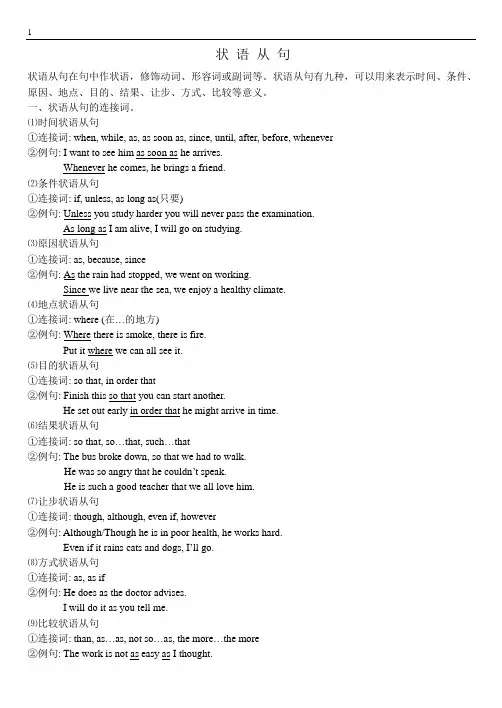
状语从句状语从句在句中作状语,修饰动词、形容词或副词等。
状语从句有九种,可以用来表示时间、条件、原因、地点、目的、结果、让步、方式、比较等意义。
一、状语从句的连接词。
⑴时间状语从句①连接词: when, while, as, as soon as, since, until, after, before, whenever②例句: I want to see him as soon as he arrives.Whenever he comes, he brings a friend.⑵条件状语从句①连接词: if, unless, as long as(只要)②例句: Unless you study harder you will never pass the examination.As long as I am alive, I will go on studying.⑶原因状语从句①连接词: as, because, since②例句: As the rain had stopped, we went on working.Since we live near the sea, we enjoy a healthy climate.⑷地点状语从句①连接词: where (在…的地方)②例句: Where there is smoke, there is fire.Put it where we can all see it.⑸目的状语从句①连接词: so that, in order that②例句: Finish this so that you can start another.He set out early in order that he might arrive in time.⑹结果状语从句①连接词: so that, so…that, such…that②例句: The bus broke down, so that we had to walk.He was so angry that he couldn’t speak.He is such a good teacher that we all love him.⑺让步状语从句①连接词: though, although, even if, however②例句: Although/Though he is in poor health, he works hard.Even if it rains cats and dogs, I’ll go.⑻方式状语从句①连接词: as, as if②例句: He does as the doctor advises.I will do it as you tell me.⑼比较状语从句①连接词: than, as…as, not so…as, the more…the more②例句: The work is not as easy as I thought.Actions speak louder than words.The more I look at the picture, the better I like it.二、易混连接词区分。
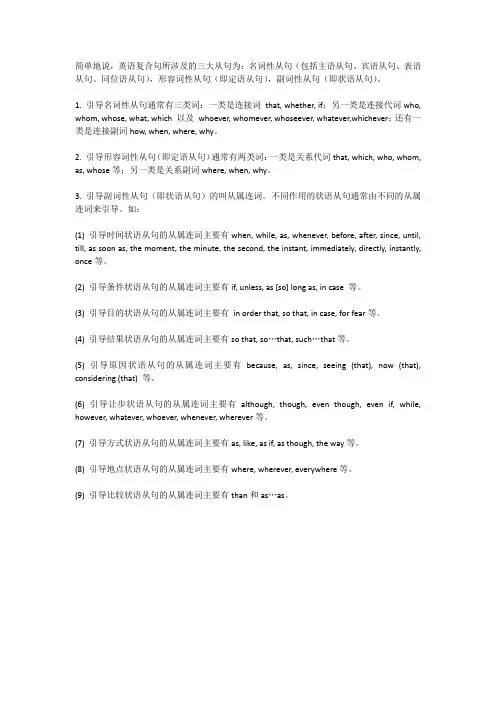
简单地说,英语复合句所涉及的三大从句为:名词性从句(包括主语从句、宾语从句、表语从句、同位语从句),形容词性从句(即定语从句),副词性从句(即状语从句)。
1. 引导名词性从句通常有三类词:一类是连接词that, whether, if;另一类是连接代词who, whom, whose, what, which 以及whoever, whomever, whoseever, whatever,whichever;还有一类是连接副词how, when, where, why。
2. 引导形容词性从句(即定语从句)通常有两类词:一类是关系代词that, which, who, whom, as, whose等;另一类是关系副词where, when, why。
3. 引导副词性从句(即状语从句)的叫从属连词。
不同作用的状语从句通常由不同的从属连词来引导。
如:(1) 引导时间状语从句的从属连词主要有when, while, as, whenever, before, after, since, until, till, as soon as, the moment, the minute, the second, the instant, immediately, directly, instantly, once等。
(2) 引导条件状语从句的从属连词主要有if, unless, as [so] long as, in case 等。
(3) 引导目的状语从句的从属连词主要有in order that, so that, in case, for fear等。
(4) 引导结果状语从句的从属连词主要有so that, so…that, such…that等。
(5) 引导原因状语从句的从属连词主要有because, as, since, seeing (that), now (that), considering (that) 等。
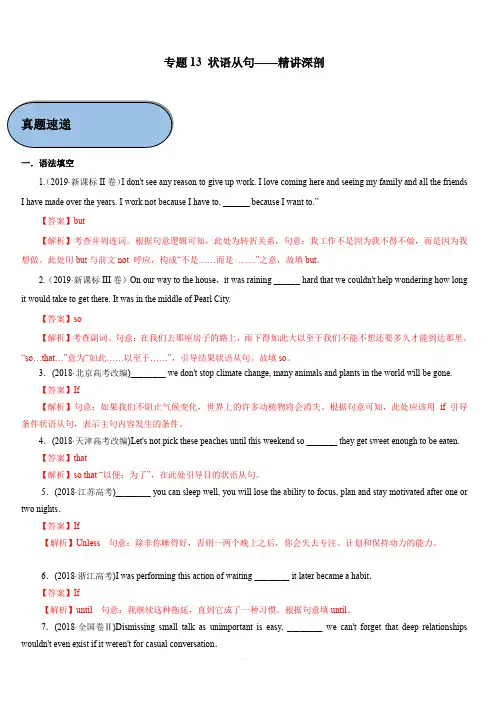
专题13 状语从句——精讲深剖一.语法填空1.(2019·新课标II卷)I don't see any reason to give up work. I love coming here and seeing my family and all the friendsI have made over the years. I work not because I have to, ______ because I want to.”【答案】but【解析】考查并列连词。
根据句意逻辑可知,此处为转折关系,句意:我工作不是因为我不得不做,而是因为我想做。
此处用but与前文not 呼应,构成“不是……而是……”之意,故填but。
2.(2019·新课标III卷)On our way to the house,it was raining ______ hard that we couldn't help wondering how long it would take to get there. It was in the middle of Pearl City.【答案】so【解析】考查副词。
句意:在我们去那座房子的路上,雨下得如此大以至于我们不能不想还要多久才能到达那里。
“so…that…”意为“如此……以至于……”,引导结果状语从句。
故填so。
3.(2018·北京高考改编)________ we don't stop climate change, many animals and plants in the world will be gone.【答案】If【解析】句意:如果我们不阻止气候变化,世界上的许多动植物将会消失。
根据句意可知,此处应该用if 引导条件状语从句,表示主句内容发生的条件。
4.(2018·天津高考改编)Let's not pick these peaches until this weekend so _______ they get sweet enough to be eaten.【答案】that【解析】so that “以便;为了”,在此处引导目的状语从句。
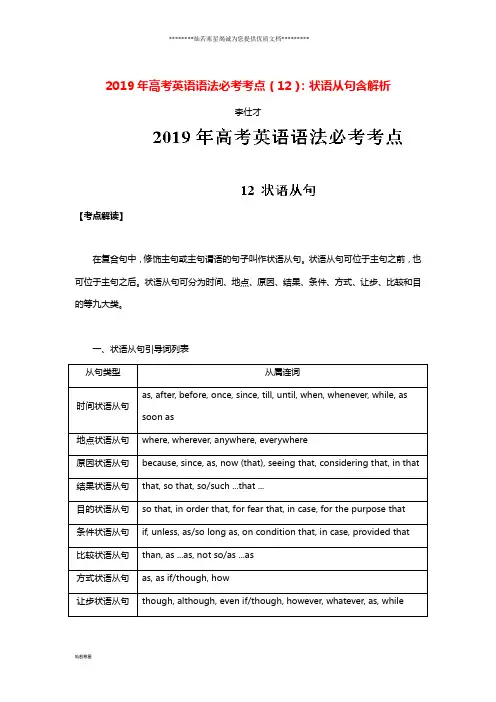
2019年高考英语语法必考考点(12):状语从句含解析李仕才【考点解读】在复合句中,修饰主句或主句谓语的句子叫作状语从句。
状语从句可位于主句之前,也可位于主句之后。
状语从句可分为时间、地点、原因、结果、条件、方式、让步、比较和目的等九大类。
一、状语从句引导词列表从句类型从属连词时间状语从句as, after, before, once, since, till, until, when, whenever, while, as soon as地点状语从句where, wherever, anywhere, everywhere原因状语从句because, since, as, now (that), seeing that, considering that, in that 结果状语从句that, so that, so/such ...that ...目的状语从句so that, in order that, for fear that, in case, for the purpose that条件状语从句if, unless, as/so long as, on condition that, in case, provided that 比较状语从句than, as ...as, not so/as ...as方式状语从句as, as if/though, how让步状语从句though, although, even if/though, however, whatever, as, while【点睛】(1)上述有些连词除了能引导状语从句外,还可引导定语从句和名词性从句。
在使用的时候,要根据句子结构和句意来判别和区分不同的从句,正确使用引导词。
以where为例,试比较下列多种从句的区别。
You are to find it where you left it. (地点状语从句)Tell me the address where he lives. (定语从句,先行词为the address)I don’t know where he came from. (宾语从句)Where he has gone is not known yet. (主语从句)This place is where they once hid. (表语从句)(2)在两个分句间要有一个且只有一个连词,千万不能按汉语习惯。
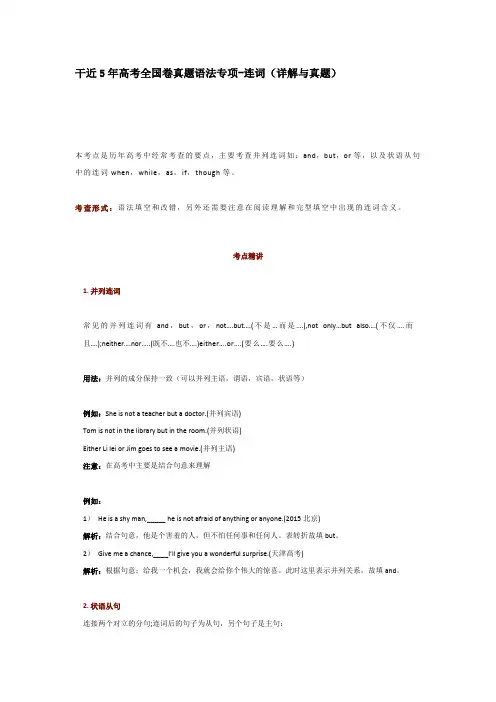
干近5年高考全国卷真题语法专项-连词(详解与真题)本考点是历年高考中经常考查的要点,主要考查并列连词如:and,but,or等,以及状语从句中的连词when,while,as,if,though等。
考查形式:语法填空和改错,另外还需要注意在阅读理解和完型填空中出现的连词含义。
考点精讲1. 并列连词常见的并列连词有and,but,or,not….but….(不是…而是….),not only…but also….(不仅….而且….);neither….nor…..(既不….也不….)either….or….(要么….要么….)用法:并列的成分保持一致(可以并列主语,谓语,宾语,状语等)例如:She is not a teacher but a doctor.(并列宾语)Tom is not in the library but in the room.(并列状语)Either Li lei or Jim goes to see a movie.(并列主语)注意:在高考中主要是结合句意来理解例如:1)He is a shy man,_____ he is not afraid of anything or anyone.(2015北京)解析:结合句意,他是个害羞的人,但不怕任何事和任何人。
表转折故填but。
2)Give me a chance,____I’ll give you a wonderful surprise.(天津高考)解析:根据句意:给我一个机会,我就会给你个伟大的惊喜。
此时这里表示并列关系,故填and。
2. 状语从句连接两个对立的分句;连词后的句子为从句,另个句子是主句;例如:If you can study hard,(从句) you will be successful.(主句)1) when, while ,as的用法都可以表示“当…..时候”;可以相互替换;注意:when还可以表示这时,突然的意思;例如:We are having a meeting when someone breaks into the room.(when这里表示突然)while可以表示然而,尽管等含义例如:He likes pop music,while I am fond of folk music.(表示对比关系)2)表示“一…….就……”的连词有:as soon as, once, immediately,instantly, the moment,the min ute, hardly……when……, no sooner…..than……;例如:As soon as I get home, I start to do my homework.3)容易混淆的连词有:as long as (只要);even if/even though即使;as if /as though 好像;now that 既然;in case 以防;万一;so that 以便于等4)让步状语从句(1)although与though可以引导让步状语从句,不能与but连用,但可以与yet连用。
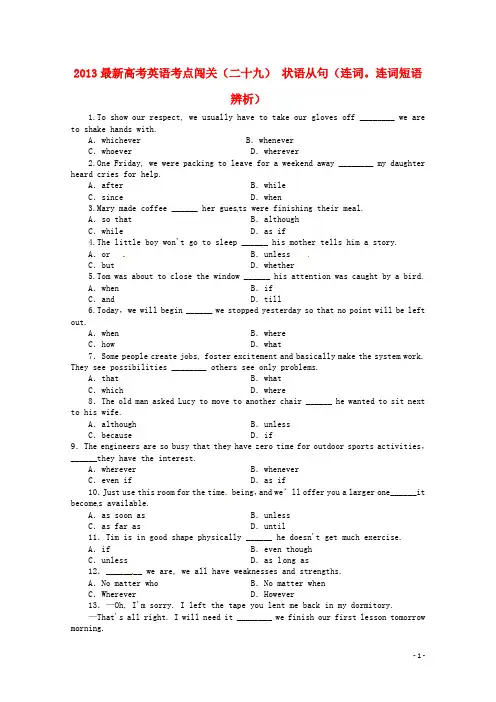
2013最新高考英语考点闯关(二十九)状语从句(连词。
连词短语辨析)1.To show our respect, we usually have to take our gloves off ________ we are to shake hands with.A.whichever B.wheneverC.whoever D.wherever2.One Friday, we were packing to leave for a weekend away ________ my daughter heard cries for help.A.after B.whileC.since D.when3.Mary made coffee ______ her gues ts were finishing their meal.A.so that B.althoughC.while D.as if4.The little boy won't go to sleep ______ his mother tells him a story.A.or B.unlessC.but D.whether5.Tom was about to close the window ______ his attention was caught by a bird.A.when B.ifC.and D.till6.Today,we will begin ______ we stopped yesterday so that no point will be left out.A.when B.whereC.how D.what7.Some people create jobs, foster excitement and basically make the system work. They see possibilities ________ others see only problems.A.that B.whatC.which D.where8.The old man asked Lucy to move to another chair ______ he wanted to sit next to his wife.A.although B.unlessC.because D.if9.The engineers are so busy that they have zero time for outdoor sports activities,______they have the interest.A.wherever B.wheneverC.even if D.as if10.Just use this room for the time being,and we’ll offer you a larger one______it become s available.A.as soon as B.unlessC.as far as D.until11.Tim is in good shape physically ______ he doesn't get much exercise.A.if B.even thoughC.unless D.as l ong as12.________ we are, we all have weaknesses and strengths.A.No matter who B.No matter whenC.Wherever D.However13.—Oh, I'm sorry. I left the tape you lent me back in my dormitory.—That's all right. I will need it ________ we finish our first lesson tomorrow morning.A.as B.untilC.unless D.after14.—How long is it ________ we last saw it snowed here?—Not sure, about eight ye ars.A.since B.beforeC.after D.when15.—Hasn't the thief admitted his crime by now?—No, ________ questioned many times.A. ifB. thoughC. unlessD. once2013最新高考英语考点闯关(二十九)状语从句(连词。
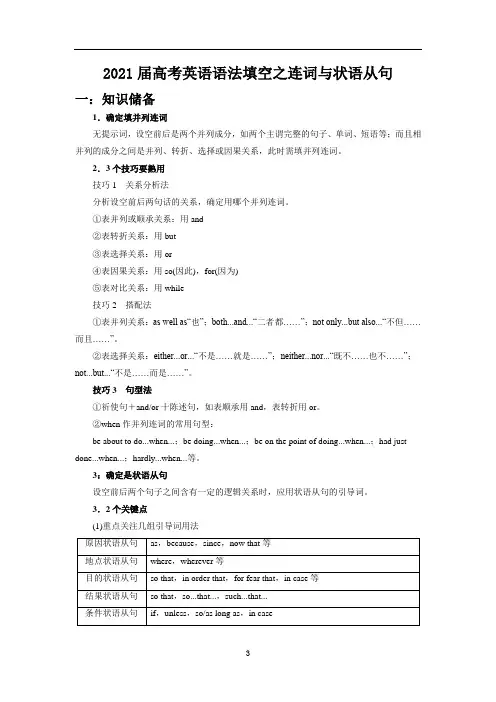
2021届高考英语语法填空之连词与状语从句一:知识储备1.确定填并列连词无提示词,设空前后是两个并列成分,如两个主谓完整的句子、单词、短语等;而且相并列的成分之间是并列、转折、选择或因果关系,此时需填并列连词。
2.3个技巧要熟用技巧1关系分析法分析设空前后两句话的关系,确定用哪个并列连词。
①表并列或顺承关系:用and②表转折关系:用but③表选择关系:用or④表因果关系:用so(因此),for(因为)⑤表对比关系:用while技巧2搭配法①表并列关系:as well as“也”;both...and...“二者都……”;not only...but also...“不但……而且……”。
②表选择关系:either...or...“不是……就是……”;neither...nor...“既不……也不……”;not...but...“不是……而是……”。
技巧3句型法①祈使句+and/or十陈述句,如表顺承用and,表转折用or。
②when作并列连词的常用句型:be about to do...when...;be doing...when...;be on the point of doing...when...;had just done...when...;hardly...when...等。
3:确定是状语从句设空前后两个句子之间含有一定的逻辑关系时,应用状语从句的引导词。
3.2个关键点(1)重点关注几组引导词用法让步状语从句though/although,as,even if/though,while,however,whether...or...,whatever,whoever,no matter how/what/which等①动作同时发生:when,whenever,while,as等。
②动作接连发生:as soon as,the minute,immediately,once等。
③先后发生:before,after等。
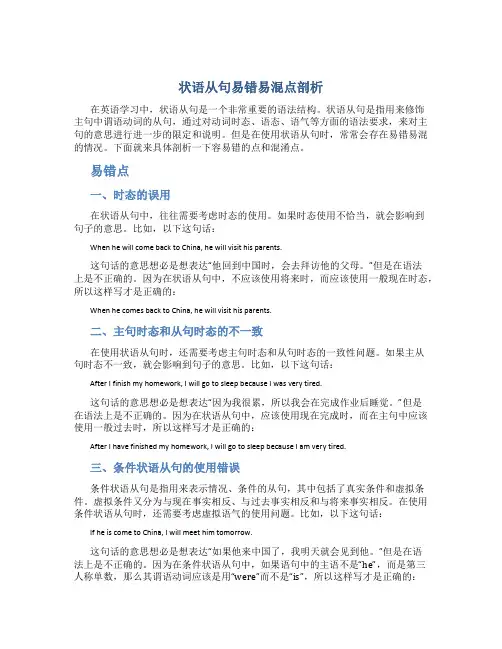
状语从句易错易混点剖析在英语学习中,状语从句是一个非常重要的语法结构。
状语从句是指用来修饰主句中谓语动词的从句,通过对动词时态、语态、语气等方面的语法要求,来对主句的意思进行进一步的限定和说明。
但是在使用状语从句时,常常会存在易错易混的情况。
下面就来具体剖析一下容易错的点和混淆点。
易错点一、时态的误用在状语从句中,往往需要考虑时态的使用。
如果时态使用不恰当,就会影响到句子的意思。
比如,以下这句话:When he will come back to China, he will visit his parents.这句话的意思想必是想表达“他回到中国时,会去拜访他的父母。
”但是在语法上是不正确的。
因为在状语从句中,不应该使用将来时,而应该使用一般现在时态,所以这样写才是正确的:When he comes back to China, he will visit his parents.二、主句时态和从句时态的不一致在使用状语从句时,还需要考虑主句时态和从句时态的一致性问题。
如果主从句时态不一致,就会影响到句子的意思。
比如,以下这句话:After I finish my homework, I will go to sleep because I was very tired.这句话的意思想必是想表达“因为我很累,所以我会在完成作业后睡觉。
”但是在语法上是不正确的。
因为在状语从句中,应该使用现在完成时,而在主句中应该使用一般过去时,所以这样写才是正确的:After I have finished my homework, I will go to sleep because I am very tired.三、条件状语从句的使用错误条件状语从句是指用来表示情况、条件的从句,其中包括了真实条件和虚拟条件。
虚拟条件又分为与现在事实相反、与过去事实相反和与将来事实相反。
在使用条件状语从句时,还需要考虑虚拟语气的使用问题。
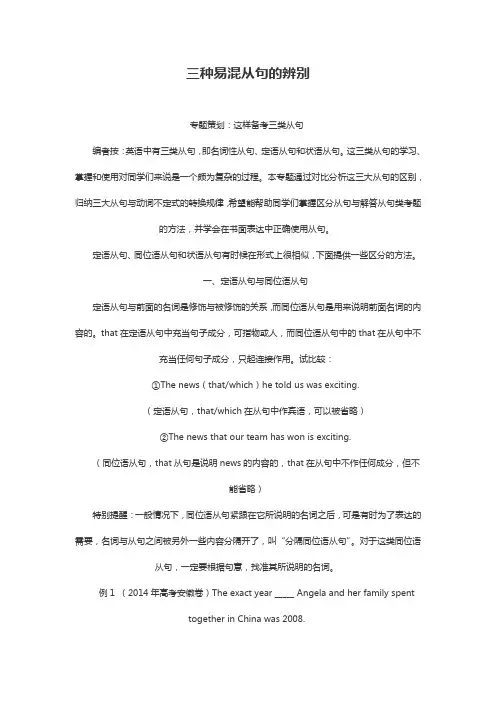
三种易混从句的辨别专题策划:这样备考三类从句编者按:英语中有三类从句,即名词性从句、定语从句和状语从句。
这三类从句的学习、掌握和使用对同学们来说是一个颇为复杂的过程。
本专题通过对比分析这三大从句的区别,归纳三大从句与动词不定式的转换规律,希望能帮助同学们掌握区分从句与解答从句类考题的方法,并学会在书面表达中正确使用从句。
定语从句、同位语从句和状语从句有时候在形式上很相似,下面提供一些区分的方法。
一、定语从句与同位语从句定语从句与前面的名词是修饰与被修饰的关系,而同位语从句是用来说明前面名词的内容的。
that在定语从句中充当句子成分,可指物或人,而同位语从句中的that在从句中不充当任何句子成分,只起连接作用。
试比较:①The news(that/which)he told us was exciting.(定语从句,that/which在从句中作宾语,可以被省略)②The news that our team has won is exciting.(同位语从句,that从句是说明news的内容的,that在从句中不作任何成分,但不能省略)特别提醒:一般情况下,同位语从句紧跟在它所说明的名词之后,可是有时为了表达的需要,名词与从句之间被另外一些内容分隔开了,叫“分隔同位语从句”。
对于这类同位语从句,一定要根据句意,找准其所说明的名词。
例1 (2014年高考安徽卷)The exact year _____ Angela and her family spenttogether in China was 2008.A. whenB. whereC. whyD. which解析:本题中的定语从句的先行词是the exact year,后面的定语从句Angela and her family spent together in China中动词spent后面缺少宾语,所以使用关系代词which 引导这个定语从句,并在句中作宾语。
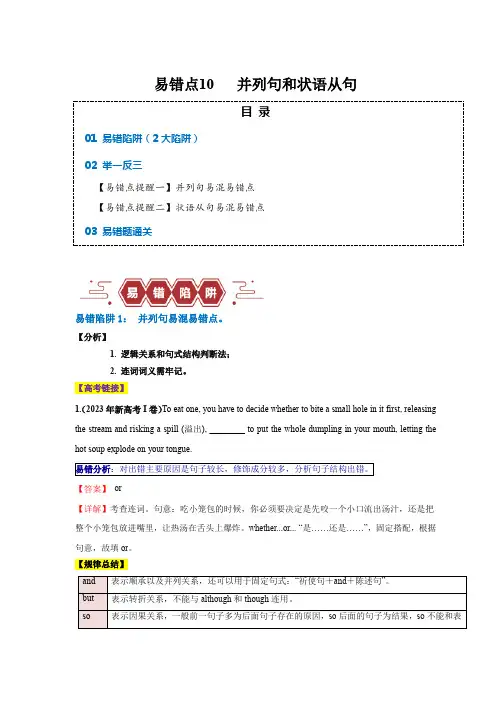
易错点10 并列句和状语从句目录01 易错陷阱(2大陷阱)02 举一反三【易错点提醒一】并列句易混易错点【易错点提醒二】状语从句易混易错点03 易错题通关易错陷阱1:并列句易混易错点。
【分析】1. 逻辑关系和句式结构判断法;2. 连词词义需牢记。
【高考链接】1.(2023年新高考I卷)To eat one, you have to decide whether to bite a small hole in it first, releasing the stream and risking a spill (溢出), ________ to put the whole dumpling in your mouth, letting the hot soup explode on your tongue.【答案】or【详解】考查连词。
句意:吃小笼包的时候,你必须要决定是先咬一个小口流出汤汁,还是把整个小笼包放进嘴里,让热汤在舌头上爆炸。
whether...or... “是……还是……”,固定搭配,根据句意,故填or。
【规律总结】示原因的从属连词because连用。
“或者”为表示选择关系的连词,or还可译为“否则”,可用于句型:“祈使句+or+陈述句”。
both... and..., neither... nor..., not only...but also..., either...or..., not...but...特殊搭配解题。
作并列连词。
when表示“在那时,突然”;while表示“然而,而”,表对比或转折关系。
并列连词when常用于以下句型中:...was/were doing ...when ……正在做……突然……...was/were about to do ...when ... ……刚要做……突然……...was/were on the point of doing ...when ... ……刚要做……突然……...had just done ...when ... ……刚/一……就……I had just finished my homework when Tom came to me.我刚写完作业,Tom就来找我了。
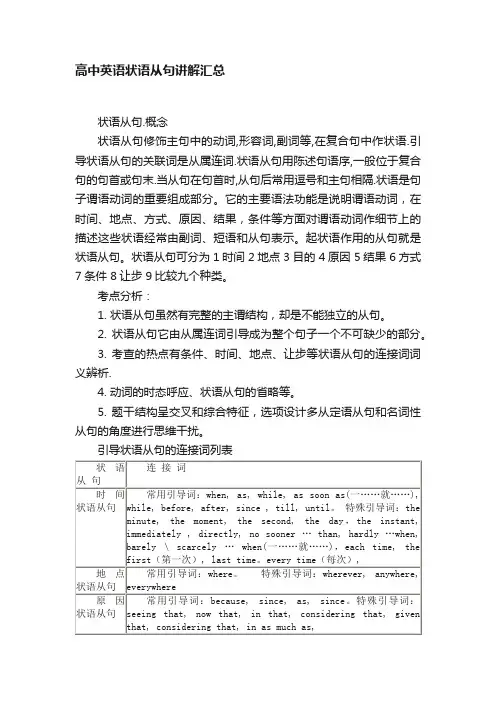
高中英语状语从句讲解汇总状语从句.概念状语从句修饰主句中的动词,形容词,副词等,在复合句中作状语.引导状语从句的关联词是从属连词.状语从句用陈述句语序,一般位于复合句的句首或句末.当从句在句首时,从句后常用逗号和主句相隔.状语是句子谓语动词的重要组成部分。
它的主要语法功能是说明谓语动词,在时间、地点、方式、原因、结果,条件等方面对谓语动词作细节上的描述这些状语经常由副词、短语和从句表示。
起状语作用的从句就是状语从句。
状语从句可分为1时间 2地点 3目的 4原因 5结果 6方式7条件 8让步 9比较九个种类。
考点分析:1. 状语从句虽然有完整的主谓结构,却是不能独立的从句。
2. 状语从句它由从属连词引导成为整个句子一个不可缺少的部分。
3. 考查的热点有条件、时间、地点、让步等状语从句的连接词词义辨析.4. 动词的时态呼应、状语从句的省略等。
5. 题干结构呈交叉和综合特征,选项设计多从定语从句和名词性从句的角度进行思维干扰。
引导状语从句的连接词列表★★★★第一讲:时间状语从句★★★★1. 表示“一…就…”的连接词引导的时间状语从句:1由“as soon as, th e instant/ the moment, the minute, instantly, directly, once, immediately”等引导的时间状语从句:The moment he saw me, he ran away. 他一看见我,就跑了。
My sister came directly she got my message. 我妹妹一收到我的信息就来了。
Once printed, this book will be very popular.一印刷,这本书就将非常流行。
Instantly the button is pressed, the mine explodes.这个扭一按下去,这矿就爆炸了。
They told me the news immediately they got the message.他一得到信息就马上把消息告诉了我。
词汇积累——英语易混词辨析1. after, in这两个介词都可以表示“……(时间)以后”的意思。
after以过去为起点,表示过去一段时间之后,常用于过去时态的句子中。
如:She went after three days.她是三天以后走的。
in以现在为起点,表将来一段时间以后,常用于将来时态的句子中。
如:She will go in three days.她三天以后要走。
2. how long, how often, how soonhow long指“多长时间”,主要用来对一段时间(如three days, four weeks等)提问。
如:How long ago was it?这是多久前的事了?how often指“每隔多久”,主要用来对频率副词或状语(如once a week等)提问。
如:— How often does he come here?— Once a month.——他(每隔)多久来一次?——每月一次。
how soon指“再过多久”,主要用来对表示将来的一段时间(in an hour, in two weeks等)提问。
如:How soon can you come?你多快能赶来?3. few, a few, little, a little, several, somefew和little的意思是否定的,表示“很少”或“几乎没有”;而a few和a little的意思是肯定的,表示“有一些,有一点儿”。
few和a few修饰可数名词;little和a little修饰不可数名词。
several用于修饰可数名词,语意比a few和some更肯定,含有“好几个”的意思。
some可修饰可数名词,也可修饰不可数名词,从数量上说,它有时相当于a few 或a little,有时指更多一些的数量。
4. the other, anotherthe other指两个人或事物中的“另一个”,表示特指。
专题08 并列连词和状语从句易错点1 并列连词之间的误用1. I’m sorry, _________ I won't be able to come tonight.A. forB. andC. butD. then【错因分析】容易误选 A。
学生误认为空格后的句子是用以说明I’m sorry的原因,便想当然地认为要选for来表示原因。
【试题解析】I'm sorry 后习惯上不接表示原因的连词for,而接表示转折的连词but(也可省略 but),用以委婉地提出一个使对方不快的事实。
又如: Oh, sorry, but she's out. 哦,不好意思,她出去了。
【参考答案】 C2. In much of Asia, especially the so-called “rice bowl” cultures of China, Japan, Korea, __________ Vietnam, foodis usually eaten with chopsticks.【错因分析】容易误填or。
有的学生没有真正理解空格前后两部分之间为并列关系,易误填or。
【参考答案】and3. They live in too big a house with too many rooms, or their house of life is a hut. (单句改错)【错因分析】前后句之间为转折关系,误用了表示选择的连词or。
【试题解析】句意为:他们住在拥有太多房间的一所大房子里,然而他们精神生活的房子却是一个小屋。
前后句之间应使用表示转折关系的并列连词yet/but。
【参考答案】or改为yet/but4. Neither you nor I don’t know the truth.(单句改错)【错因分析】对“neither…nor…”的用法掌握不牢。
【参考答案】删去don’t常见的并列连词1. and和or◆and的用法如下:(1) 表示另加:其意为“和”“又”“而且”。
法宝07 状语从句目录一............... 知识梳理二............... 真题回顾三............... 名校模拟练法宝07 状语从句状语是谓语的另一个附加成分,主要用于修饰动词的状态,如时间、地点、方式等。
状语从句即为句子中充当状语的从句。
和定语从句不同,状语从句“套路”比较单一,主要掌握不同类型下的引导词,并注意少数特殊情况即可。
01时间状语从句时间状语从句连词after as before oncesince till / until as soon as whenwhile as long as whenever no sooner … than hardly / scarely / barely … when副词immediately directly instantly名词短语the moment the minute the instant the second every time介词短语语by the time- When I arrived home, my mom was sleeping.- 当我回到家时,我母亲正在睡觉。
- As soon as I arrived home, Tom closed TV.- 我一回到家,汤姆就关了电视。
- By the time you arrived home, I had done my housework. - 当你回到家时,我已经做完了家务。
知识梳理在no sooner ... than, scarely / hardly / barely ... when 的结构中,若no sooner, scarely / hardly / barely 位于句首,需倒装。
- Hardly had I finished my housework when you arrived home.- 我刚做完家务,你就回家了。
高考英语总结高考英语易混易错词汇短语辨析高考英语总结-高考英语易混易错词汇、短语辨析高考英语中易混淆、易出错的词语分析aboutaroundround作副词时都含“四处”、“遍地”的意思。
About是一个常见的词,例如:lookabout四处看。
Around的基本含义是about,所以lookabout=lookabout,但在以下短语中,Around与正式无关,例如:travelaround各处旅行Round和around在非正式用法中可以互换,但通常Round更简洁。
在正式用语中,round通常用于指代“轮换”,而around则用于指代“无处不在”和“无处不在”,例如:sheturnedroundatsuchanoise.听到这样的吵声,她回头看。
ihavebeenlookingforitallaround.我到处都找过了。
此外,在英国人使用round的地方,美国人倾向于使用around,例如:aboveall;afterall;atall最重要的意思是“尤其”、“首先”、“最重要”。
它通常位于句首或句中。
它被用作括号来强调。
例如:butabovealltellmequicklywhatihavetodo.可首先快些告诉我该做什么。
aclockmustaboveallkeepsgoodtime.时钟最重要的是必须走得准。
毕竟是指“毕竟”、“毕竟”、“毕竟”、“最终”和“最终”。
它在句子中有一个灵活的位置。
它可以位于句子的开头、中间或结尾。
例如:afterall,yourbirthdayisonlytwoweeksaway.毕竟,两周后就是你的生日。
heis,afterall,asmallchild.他毕竟还是个小孩子。
hefailedafterall.他终于失败了。
当用于否定句时,atall的意思是“最轻微的;基本的”,当用于疑问句时,它的意思是“准确地;到最后”,当用于条件句时,它通常被翻译为“严重的;真实的”。
高考真题状语从句解析彻底学会,冲刺高分,还要有正确的训练方法,你想要学习密集?关注我,留言哦1.(2019·江苏)China's image is improving steadily, with more countries_______its role in international affairs.()A.recognizing B.being recognizedC.to be recognized D.recognized本题考查with复合结构.根据句意和结构可知这句话使用with复合结构, more countries和recognize是主动关系,用现在分词作宾语补足语.故选:A.2.(2009·海南)Now that we've discussed our problem,are people happy with the decisions ?()A.taking B.take C.taken D.to take考查非谓语动词.句中包含with的复合结构,with+宾语+宾语补足语,这里的decisions是take的宾语,具有动宾关系,因此用过去分词,作后置定语,故答案为C.3.(2008·香港)With a lot of tough problems______,the manager was as nervous as cat on hot bricks.()A.settle B.to settleC.being settle D.settled根据句意和结构可知这句话使用with复合结构,with+宾语+宾语补足语,根据the manager was as nervous as cat on hot bricks可知,问题有待解决,用不定式表示将来.故选:B.WIth 复合句子结构。
让步状态从句系列:1.(2015·香港)______ they say it aloud or not, most men expected their wives to be faithful.()A.If B.What C.Whether D.Even本题考查连词辨析.if如果;what什么;whether是否,和or not搭配引导让步状语从句;even甚至.根据句意和or not可知用whether.故选:C.2.(2011·辽宁)No matter how ,it is not necessarily lifeless.()A.a desert may be dry B.dry a desert may beC.may a desert be dry D.dry may a desert be答案:B 本题考查让步状语从句.how与形容词和可数名词单数连用的顺序为:how+形容词+a(n)+可数名词单数,与其用法一样的还有so,too等.如:so difficult a question 如此难的一个问题;It's too long a Journey to make in one day.旅程太远,一天之内到不了.故选B3.(2010·上海) you may have,you should gather your courage to face the challenge.()A.However a serious problemB.What a serious problemC.However serious a problemD.What serious a problem答案:C 本题考查让步状语从句,what引导的属于感叹句,不能引导让步状语从句,however引导让步状语从句,其结构为:however+adj/adv+主+谓或者是however+adj+a+n,+主+谓,所以答案应为C.故选:C.4.(2010·新课标Ⅱ)Though ______ to see us,the professor gave us a warm welcome.()A.surprise B.was surprisedC.surprised D.being surprised答案:C 本题考查让步状语从句中的省略.过去分词作状语表示分词与句子主语为被动关系.表示某人感到惊讶应该用surprised的形式所以可以排除A和D两项.当从句中的主语和主句中的主语一致,可以省略从句中的主语和be动词,不能单独省略主语,可排除B.所以,本句补全之后应该是:Though the professor wassurprised to see us,the professor gave us a warm welcome.故选:C.5.(2009·重庆)Unsatisfied ________ with the payment,he took the job just to get some work experience.()A.though was he B.though he wasC.he was though D.was he though答案是B.本题考查的是though引导的让步状语从句.though 表示"虽然"引导让步状语从句,可用正常语序,也可用倒装语序;倒装是将表语、状语或谓语动词中的实意动词提到句首;本句正常语序为"though he was unsatisfied with the payment",倒装语序将表语unsatisfied提到句首,故答案选择B.6.(2005·香港)T ony's parents were tired,________they had to wait for some more news about Tony before they could have a rest.()A.if B.when C.though D.for本题考查连词辨析.if如果;when当…时候;though虽然;for 因为.根据句意可知两句话有因果关系,用for.故选:D.结果状态从句【1】1.(2009·上海)The Great Wall is ________ tourist attraction that millions of people pour in every year.()A.so a well-known B.a so well-knownC.such well-known a D.such a well-known答案:D解析:根据所给选项及题干可知本题考查so/such…that"如此…以至于"这一结构.需要注意的是so后面接的是形容词或副词而such 后面接的是名词或名词短语,本题横线后面是名词短语"著名景点",故A、B选项先直接排除;C选项顺序错误(正确的应该为such a well-known),排除.综上,本题答案为D选项.拓展:本题用so 的正确表达是The Great Wall is so well-known a tourist attraction that…地点状态从句:【5】1.(2014·重庆)Half an hour later,Lucy still couldn't get a taxi ________ the bus had dropped her.()A.until B.when C.although D.where答案D此句是复合句,从句缺少连接副词.从题意看,意思是"她不能在汽车放下她的地方打到的士".此处需引导一个地点状语从句,故用连接副词where.故选D.2.(2012·天津)Everything was placed exactly ___________he wanted it for the graduation ceremony.()A.while B.when C.where D.though答案:C根据 was placed (被放在)可知其后为地点状语,where引导地点状语从句,在从句中作地点状语,这里缺少地点状语"所放的位置",故C项符合语境.故选:C.3.(2009·江苏) __ unemployment and crime are high,it can be assumed that the latter is due to the former.()A.Before B.Where C.Unless D.Until答案:BA.引导时间状语从句,在…之前;B.引导地点状语从句,在…地方;C.引导条件状语从句,除非,如果不;D.引导时间状语从句,直到…;此处用来引导地点状语从句,意为:在…地方;故用从属连词where,故选B.4.(2009·山东)The little girl who got lost decided to remain _________she was and wait tor her mother.()A.where B.what C.how D.who答案:A句中she was作remain的状语,表示地点;where表示地点,what表示事物,how表示方式,who指人;根据句意,故选:A.5.(2005·香港)The users of this new mobile phone can type in e-mails or long texts easily_________they happen to be.()A.where B.wherever C.what D.whatever根据句意和结构可知这里是地点状语从句,wherever=no matter where.表示"无论在什么地方".whatever引导名词性从句,这里不缺主语或宾语,缺少地点状语从句.故选:B.时间状态从句:【9】1.(2016·香港)How long is it__________we last went to the theatre?()A.as B.since C.although D.until根据句意和结构可知这句话使用句型It is+一段时间+since…意为"自从…到现在有多久".as正如;although虽然;until直到.故选:B.2.(2014·香港)Why buy a newspaper___________you can read the news online for free?()A.when B.where C.which D.what本题考查连词辨析.when这里表示"既然",where哪里;which 哪个;what什么.根据句意和上下文逻辑关系,可知用when.故选:A.3.(2014·江西)It was the middle of the night __ my father woke me up and told me to watch the football game.()A.that B.as C.which D.when答案D.由句子意思分析可知,my father woke me up and told me to watch the football game.作状语.即my father woke me up and told me to watch the football game in the middle of the night是状语从句.因此D选项正确.如果在原题的短语the middle of the night前加个介词in 的话,那么就变成了强调句型(这样去掉it was…that…三个词,句子意思完整,成分齐全).所以此题选A选项是错误的.故选:D.4.(2013·浙江)There are some health problems that,when ________ in time,can become bigger ones later on.()A.not treatedB.not being treatedC.not to be treatedD.not having been treated答案:A.原来完整的句子为There are some health problems that,when they are not treated in time,can become bigger ones later on.这里省略了they are.表示被动,属于状语从句的省略用法.to be done 表将来和被动,常用作宾语补足语.表示主语让别人做,to do主语亲自做.用在此处不合适;故选:A.5.(2011·山东)When I got on the bus,I_____I had left my wallet at home.()A.was realizing B.realizedC.have realized D.would realize答案:B.根据前面从句"when I got on the bus"可知,从句用的是一般过去时,那主句也应该用一般过去时,故这题答案选B6.(2009·上海)You can't borrow books from the school library ______ you get your student card.()A.before B.if C.while D.as答案:Abefore之前;if如果;while当…时候;as因为,作为;句意表达的是你拿到学生卡后才能借书,要用before来构成.故选A.7.(2009·福建)Jane had just finished her homework ________ her mom asked her to practice playing the violin yesterday.()A.when B.while C.after D.before答案:A.根据选项when当…时候,表示时间点,这时="at"this/that time,; while当….时候,表示时间段; after在…后面;before 在….前面,句意:简刚刚完成作业这时妈妈叫她练习钢琴.故选A.同时注意固定句型had done sth when sth happened8.(2009·重庆)Peter was so excited _________he received an invitation from his friend to visit Chongqing.()A.where B.that C.why D.when答案:D.根据选项,如果是B,意思是:他如此高兴以致于他收到去…的邀请,句意不通.所以应该是D.当皮特收到来自朋友的邀请他访问重庆的信时,他是如此的兴奋.9.(2008·香港)- How long do you think the room will be ready_____ I can go back to work?- Well, probably by next weekend.()A.before B.until C.when D.that根据句意和结构可知这句话使用before引导时间状语从句,意为"在…之前",until直到;when既然,当…时候;that无意义.故选:A.条件状态从句:【7】1.(2019•天津)T om is so independent that he never asks his parents' opinion________he wants their support.()A.since B.once C.unless D.after收录:2019/6/10组卷:54真题:1难度:0.62.(2017•澳门)_______ something unexpected happens,I'll see you tomorrow at school.()A.Before B.Unless C.Although D.Because收录:2018/9/3组卷:30真题:1难度:0.83.(2016•香港)T om is never ashamed of what he does,________he ends up doing something wrong()A.as though B.even if C.even so D.as if收录:2018/9/4组卷:33真题:1难度:0.94.(2014•香港)___________something is done,there will be more pollution in the air in this area.()A.If B.Since C.Although D.Unless收录:2018/9/3组卷:18真题:1难度:0.85.(2009•陕西)My parents don't mind what job I do I am happy.()A.even though B.as soon asC.as long as D.as though收录:2017/3/21组卷:79真题:2难度:0.96.(2009•浙江)The medicine works more effectively ______ you drink some hot water after taking it.()A.as B.until C.although D.if收录:2017/3/18组卷:82真题:2难度:0.97.(2007•香港)Don't promise anything ________you're 100 percent sure.()A.as B.when C.because D.unless收录:2018/9/3组卷:16真题:1难度:0.8。
1.时间状语从句常见的从属连词有:(注意其汉语意义)2.when, while, as, before, after, since, until (till) once as soon as, the moment, the minute, immediately, directly, each/every time, the first time, the last time, next time, by the time, whenever等。
例如:3.Every/Each time I was in trouble, he would come to my help.4.I thought her nice and honest the first time I met her.注意:(1)when, while, as的区别:5.1)when引导从句时,主从句的动作有先有后,也可以同时进行,从句的动作可以是持续性的,也可以是短暂的。
如:6.When I got to the airport, the plane had already taken off. (主先从后)(短暂性)7.When I lived there, I used to go to the seaside on Sundays. (同时) (持续性)8.When the movie ended, the people went back. (从先主后)9.2)while侧重主从句动作的对比,且从句的动词必须是持续性的。
如:10.While we were chatting she was looking at the time table on the wall.11.3)as引导从句时侧重主从句动作同时或几乎同时进行,从句的动作可以是持续性的,也可以是短暂的。
如:12.Sometimes I watch TV as I am having breakfast.13.4)when和while还可以是并列连词,意思分别是“就在这时”,“然而”。
如:14.I was having a rest on the sofa when the telephone rang.15.They were surprised that a child should work out the problem while they couldn’t .注:并列连词when常用与以下句型中:①…was/were doing…when…(正在做…突然)②…was/were about to do…when…(刚要做…突然)③…was/were on the point of doing…when…(刚要做…突然)④…had just done…when….(刚一…就)⑤Hardly/Scarcely had…done…when…(刚一…就)(2)before引导从句时,词义非常灵活,注意下列句子中的before的词义:1.Before I could get in a word, the tailor had measured me.(还没来得及…就)2.We hadn’t run a mile before he felt tired.(还没…就)3.We had sailed 4 days before we saw land.(…才…)4.Please write it down before you forget it.(趁还…没就)(3)till (until) 和not…till (until)1) till (until):主句谓语动词必须是持续性的,意思是“到…为止“如:He remained there till/until she arrived.2)not…till (until)…: 主句谓语动词必须是短暂性的,意思是“直到…才”如:She won’t go to bed till/until he returns home.3)not…until还有强调式和倒装式:强调句:It is not until he returns home that she will go to bed.倒装句:Not until he returns home will she go to bed.(4)几个极易混淆的时间状语从句:1) It was +时间点+when…(当的时候时间是)It was 5 am when we arrived at the village.2) It was/will be+时间段+before…(没过…就/过了…才)It was/will be two weeks before we met/meet again.3) It is /has been +时间段+since…(自从…以来有…)It is/has been 3 years since we last met.突破点:一看be动词的时态,二看时间段还是时间点。
注意:在“It is /has been +时间段+since…”句型中,从句的动词必须是短暂性的,如果是延续性的动词,时间要从从句的动作结束时算起。
如:It is 3 years since I smoked.( 我戒烟有三年了)2.条件状语从句常见的从属连词有:if, unless, as/so long as , as/so far as, on condition that , in case(万一) , the more…, the more…等。
如:As/So far as I can see ( am concerned), it will be impossible for them to finish the task.The more books you read, the happier you will feel.(前面为从句)3.原因状语从句常见的从属连词有:because, since, now that , as等。
注意because, since, as的区别:1)why的语气最强,它引导的从句比主句更重要,从句的位置可前可后;例外回答why的问句必须使用because。
如:-Why were you absent from the meeting yesterday?-Because I was ill.2)since和now that意思是“既然”,语气仅次于because,从句的位置一般在前。
如:Since everybody is here, let’s begin our meeting.3)as的语气比since更弱,意思是“由于”,从句的位置可前可后。
如:As you didn’t turn up at yesterday’s get-together, we missed you very much.4)*for也有“因为”之意,但for是并列连词常用来来补充说明原因或用来表示推断的依据,前面常带逗号。
如:It must have rained last night, for the ground is wet.4.让步状语从句常见的从属连词有:though, although, as, even if / though, no matter wh-, wh-ever, whether…or…等。
如:However late/No matter how late he is, his family will wait for him to have dinner together.Child as he is, he knows a lot. (as引导的让步状语从句必须倒装)Whether it is fine or not, I will go boating.5.地点状语从句常见的从属连词有:*where, wherever等。
如:Put the book where it is.6.比较状语从句常见的从属连词有:*as…as, *not so (as)…as, *than等。
注意:(1)在表达倍数时,可用三种句型:1)A…+倍数+比较级+than B 如:This building is twice taller than that one.2)A…+倍数+as原级as+B 如:This building is three times as tall as that one.3)A…+倍数+the size(height, weight, length etc.) +of B 如:This building is three times the size of that one.(2) 三种句型变式:1)倍数+more+名词+than2)*倍数+as many/much +名词+asAmericans eat more than twice as many vegetables per person today as they did in 1910.It is reported that the United States uses twice as much energy as the whole of Europe.7.方式状语从句常见的从属连词有:as , as if / though 等.注意:as if / though引导的从句常用虚拟语气,表示非真实情况.He talks about the moon as if he had been there.(从句动作先发生)She treated the boy as if he were/was her own child.(主从句动作同时发生) 8.目的状语从句常见的从属连词有:so that, that, in order that,in case (以免), for fear that等。
如:Most students go to college (so) that they can be engineers, teachers or chemists.注意:从句中的情态动词can, could, may, might等提示为目的状语从句.9.结果状语从句常见的从属连词有:so…that, such…that , so that等。
如:He earned so little money that he couldn’t support his family.It is such fine weather that we all want to go to the park.Tom studied very hard so that he passed the exam.三、用法灵活的as, when, while 引导的状语从句1. as可以引导时间、原因、让步、比较和方式等5种状语从句。